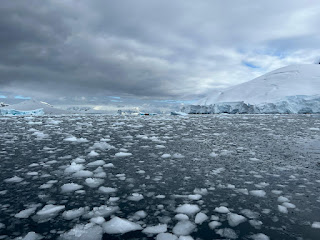Early into this expedition, we were taught to look for whales out at sea by watching for the blow of their breath. Expedition Team member Annie Inglis is a marine biologist, and she has a keen eye for spotting the spout from far off, and identifying the whale from the blow pattern and shape.
As we crossed the Drake and headed toward the polar region, whale sightings became more and more frequent, and they also got a lot closer to our ship.
There are so many whales here, humpbacks, of course, but also fin, minke, and pilot whales. We would see them cruising alongside us, ‘logging’ (sleeping at the surface) as we were anchored offshore, even witnessing a “bubble net” feeding. We recognized the humpbacks’ breathing patterns (3 breaths and then a dive), which was our cue that we would soon see a fluke as the whale dove deep (get your camera ready!). But the coolest experience was watching them from the Zodiac, where we were close enough to hear them breathe, sometimes using the sound of their breath to identify their position, and to follow and watch them do what whales do. Mostly it was them simply gliding gracefully by, hardly causing a ripple on the water as they swam right past.
Seeing these magnificent creatures in their natural habitat was a humbling experience, and what a privilege for us visitors to their world.
































































